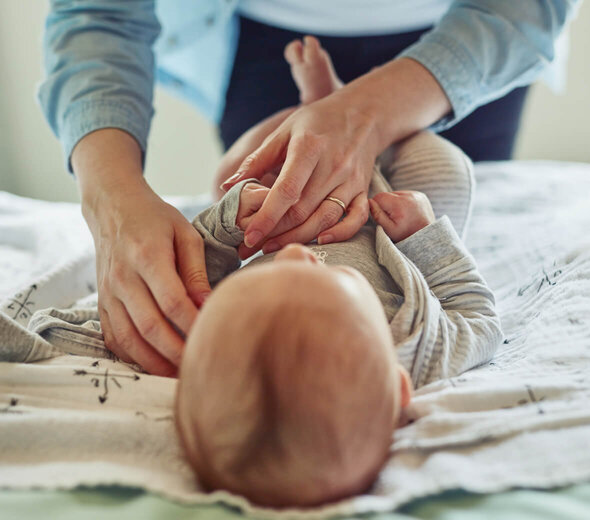

How to dress and undress a tiny baby so delicate and fragile? What to do to make the disobedient little feet go through the trouser legs and the tiny hands through the sleeves, and not the other way around? These are some of the many questions asked by young parents. As hard as it may seem, dressing a newborn is not so difficult. Peace and quiet, no hurry and comfortable baby clothes are enough to start with.
Toddlers usually don't like getting dressed or undressed, or changing clothes, or any activities connected to these. Babies seem to know dozens ways of expressing their discomfort - wriggling, arching their backs, kicking, screaming, turning purple - just to name a few. However, if you take care of both of your comfort, the baby won't protest and you will avoid unnecessary stress and spare your nerves. One solution is to choose the right clothes. Every item of clothing you buy for your little one should be designed so that it can even be taken off a sleeping baby without the need to wake him up. Why every item? Because every piece of clothing can at some point turn out to be the last clean one, and because your baby might fall asleep all of a sudden and you will want to use the opportunity. It's worth knowing that it's best to buy your baby clothes that are one size too big. First of all, they are easier to put on. Secondly, your child will be able to wear them longer. Always choose clothes made of delicate, elastic cotton. The sleeves should be wide under the armpits so it is easier to put the baby's hands through them. Shirts and bodysuits should have large neck openings and have full snap opening (newborn's head is relatively big), hats ,on the other hand, should be thin and have strings (the ones without strings can easily slide off, and the older toddlers can take them off for themselves).
Before you start dressing your baby, pick a permanent spot where you will change the baby's nappies, and dress and undress him. It can be a special changing unit, a table or a cot top changer. Changing mats are comfortable and easy to use, and you can buy them at almost any baby shop. Also prepare the clothes which you are going to put on the baby. When you're dressing or undressing the baby, or later toddler, don't make sudden movements, don't hurry and don't get angry even if things don't go the way you (and your baby) would want them to go. The beginning is not easy, but you will learn how to do it after a few times and it will go faster and easier. The most important thing in the beginning is that you stay calm and be gentle. After all, you want the baby to be happy. Talk to him in a tender voice, smile at him and look him in the eyes. For him, changing clothes is a perfect occasion for playing. He can watch your face, observe your gestures and facial expressions, and also to see what his own hands and legs look like. Give him the chance to do it. Here are some tips that might help you with dressing/undressing your baby: - hold the baby under his legs: the idea is to keep his legs lifted up and drawn to the side all the time;
Lift the baby's bottom up gently, slide your hand under one leg and grab the other one. As a result, the legs will be lifted up and to the side. - turning the baby to the sides - he won't mind it, but it will certainly make your job easier.
Ready...set…go!
1. Place a blanket or nappy on the changing mat/cot top changer. This way your baby won't have direct contact with the cold surface of the mat/changer.
2. First put the nappy on. Slide one of your hands under one leg and grab the knee of the other leg. Lift baby's bottom gently and slide the nappy underneath the baby.
3. Next comes the bodysuit. Children don't like clothes that need to be slipped over the head, therefore it's best to get over with as fast as possible. The easiest way to deal with it is to stretch the neck of the bodysuit with both hands and roll it in your hands (like you do with stockings or tights). Slip the bodysuit gently over the baby's head, then pull it over the baby's neck and shoulders. Stretch the armhole at the sleeve and put three of your fingers in from the outside. When the baby straightens his arm, grab his palm and gently pull the sleeve over his hand. This method can also be applied with shirts (unless they're snap-on shirts, which are much easier to put on).
4. After the bodysuit it's time to put on the all-in-one or the wrap-shirt and sleepsuit. First put on one of the sleeves, then roll the trouser-leg and grab it's end with one hand. Lift the baby's upper thigh and pull the trouser-leg over his foot (if you're having problems, try tickling - tickle your child gently on the tummy and he should bend his legs, which will make it easier to put the trouser-leg on). Next, slide your hand under the baby's leg, hug his hip and thigh with your hand, bend both legs gently on the tummy and turn the baby softly to the other side. Put on the other sleeve and trouser-leg using the same method. Some people start with putting the trouser-legs on, and then put on the sleeves. You can try both ways to see, which one is more comfortable for you and your child.
5. Then the socks. This is probably the easiest part, it usually doesn't require special knowledge or skills and is rather instinctive. You simply stretch the sock hole wide and pull it over the baby's foot.
6. On cool days, the baby needs an additional layer of clothes to protect him from the cold. You can e.g. put a warm blouse or sweater on him. Fortunately, they are rather easy to put on. It's even easier if they are loose. For the child's comfort keep in mind that when putting on the sleeve of the top layer, you should also grab the sleeve of the wrap-shirt/all-in-one so that the sleeve won't roll up.
7. We are almost done. The only thing left is the hat. When putting on the hat, don't pull the baby's head up. It's inadvisable. First, slide the hat gently on the top of the baby's head, then turn him on one side and pull the hat on one part of the head. Do the same thing on the other side. If the hat has strings, tie them on the side instead of under the chin, so they won't bother the baby. If you want to, you can also use the same method when holding the baby on your lap. In this position you will be able to turn him around more easily,
It's also worth knowing you only put the baby's hat on in certain cases: after bathing (for a while) and for walks (always put the hat on before going out; it protects the baby not only from cold, but also from the sun, wind and rain).
8. You are done! Your baby is dressed. Before going out for a walk, take some time to cuddle the baby. He will find it soothing as he's probably irritated after being dressed (especially if you're not very experienced yet). Just remember not to take too much time before leaving the house. Your baby is dressed for outdoors purposes and will get hot very quickly - and children usually react strongly to overheating.
Similarly to dressing up the baby, use the under-the-leg grip and turning the baby on the sides.
1. Sleepsuit. Lay the baby down on his back. Grab him under the legs and turn him on his side. Pull the sleepsuit off one leg. Switch hands, turn the baby on the other side and slide the sleepsuit off the other leg and then the bottom.
2. Bodysuit/wrap shirt. In order to take off a bodysuit or wrap shirt, place the baby in the starting position, i.e. on his back. Let's start with the sleeve. Hold the baby's elbow with one hand and slide the sleeve off with your other hand. Then turn the baby on his side (in order to get access to the other hand), repeat the previous actions, take off the other sleeve and finally the whole bodysuit/wrap shirt. The same method can be used to take off a blouse or sweater. Taking off the hat or socks, on the other hand, shouldn't cause any problems even to unexperienced parents, and therefore doesn't require instructions.
Remember that until your baby is really small, you can also dress and undress him while he's on your lap, instead of using a changing mat or changing unit. A bigger child, however, will be difficult to handle on your lap comfortably, which will make it hard both for you and him.